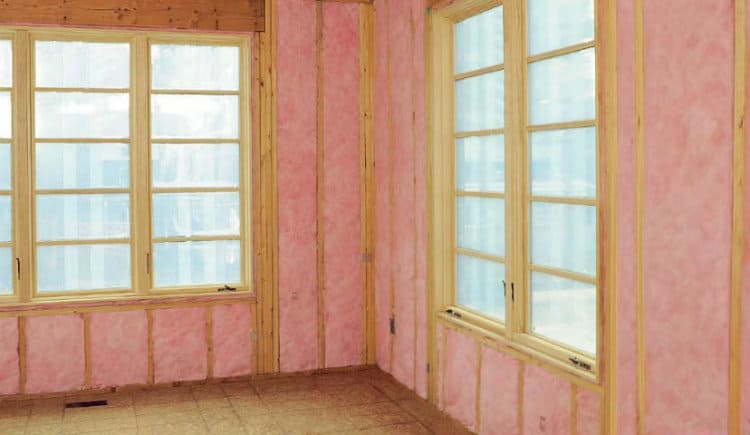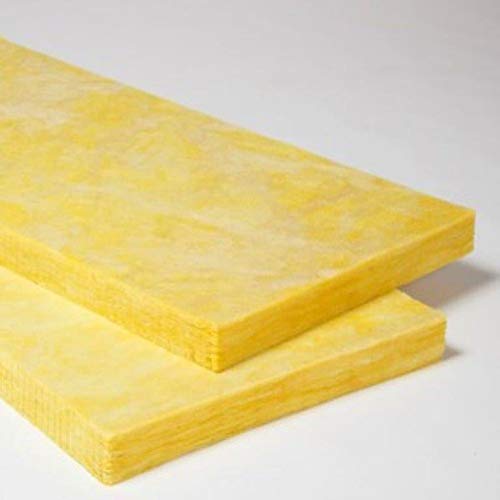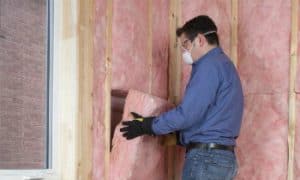My friends and I are audiophiles and one of those friends is now about to build his own house. We were chatting the other day on some of my soundproofing projects as he is interested in doing something similar to his new home. I was quick to help him understand the soundproofing properties of using fiberglass insulation and now I want to help you as well.
Is fiberglass insulation good for soundproofing? Yes, fiberglass is excellent for soundproofing. You can soundproof your walls, your ceilings and your floors. With the different formats of fiberglass insulation your home can be soundproofed in any way you desire.
I can tell you from experience that insulating over and above the normal amount of insulation that builders use will make a big difference in your home experience. It’s not just for insulating a TV room either. Insulating interior bathroom and bedroom walls makes a huge difference in your comfort. Why stop there though?! Let’s explore this some more.
What is Fiberglass Insulation?

Fiberglass insulation consists of very small particles of glass. The glass comes by way of a process from heating sand and spinning it which forms the glass.
Some manufacturers use recycled glass to produce insulation. Now you know why you got so itchy when you rolled around in batts of insulation as a child.
The more common formats of fiberglass insulation are the batts most people are familiar with as well as rolls of insulation. Other varieties would be loose fill which would be the material you see being blown into attics. Also it comes in rigid boards and insulation made specifically for ductwork.
How does Fiberglass Insulation Work?
Thermal insulation stops the transfer of heat, cold and ‘sound’ by trapping the temperatures and soundwaves in the insulation preventing them from passing through. When your desire is to provide soundproofing this is why fiberglass insulation works so well.
Is Fiberglass Good for Soundproofing?
Fiberglass insulation is a solid choice for soundproofing. The fact that fiberglass insulation will absorb sound is exactly what you want. It won’t block/reflect the sound because it is not the correct material for that. However, it will absorb the sound.
If you want to completely soundproof (meaning no sound will be heard on the other side of a wall) fiberglass might fall a bit short. Let’s face it, it’s not just about the insulation. If you have windows, doors or any other features that cannot be insulated your R-value goes down.
When asking if fiberglass is good for soundproofing to consider the NRC rating of the product. NRC stands for “Noise Reduction Coefficient” and is used to find out how much any product can absorb sound.
NRC values generally range between 0 and 1. The higher the number, the better sound absorption. It is possible to have a score higher than 1 depending on the shape and surface of an object.
Fiberglass insulation (measuring 3 ½” thick) has an NRC rating between 0.90 and 0.95. So you can see it does quite well when rated for sound reduction.
Whether talking about residential or commercial properties using fiberglass insulation greatly increases the soundproofing of the building. Standard insulating is done in walls and ceilings; I would consider insulating in all interior walls and flooring when possible for maximum sound absorption.
If you are a DIY person the fiberglass batting is a really easy way to get your soundproofing under control. Batts are easy to work with. They come in widths suitable for 16” and 24” on center studs. They also come in different thicknesses that fit either 2” x 4” or 2” x 6” stud walls.
How does Fiberglass Insulation Reduce Noise?
We have touched on the answer to this question already. However, it is good to make it clear. Fiberglass insulation helps to reduce noise by absorbing sound.
The thicker and denser the insulation the better it will absorb noise. It is a great sound barrier, yet will not stop noises 100%.
That being said it is safe to say then that fiberglass insulation is not only efficient at absorbing sound, but it also makes a pretty decent sound barrier as well.
Types of Fiberglass Insulation to Consider

There are a couple of types of fiberglass insulation to choose from for most typical applications.
- There are the batts of insulation we have covered previously in this article that are very common and well-known by most people. Batts of insulation can be purchased in different widths and thicknesses as also previously mentioned.They are easy to work with as far as cutting to fit into place if necessary. Batts are great for open wall cavities as well as between floor joists in there is something underneath like gypsum to stop them from falling through.
- Continuous rolls of insulation can be purchased in varied lengths. These are great for running in the attic between the trusses or in walls when the walls are extra tall and normal 4’ length batts don’t do the job. Continuous rolls can also be purchased in different thicknesses which will have different R values.
- If soundproofing is what you are looking for then you are in luck. Aside from regular fiberglass insulation used in normal building applications, there is soundproofing insulation for you to purchase. They come in batts and are great for any application where controlling noise levels is important.
What is the Difference between Fiberglass and Cellulose Insulation?
- Cellulose is the other type of insulation. Cellulose is the loose fluffy insulation that is blown into place. This type is typically used in areas that are harder to get into to insulate like an attic for instance. The cellulose is loaded in an insulating blower and blown out of a large hose quite far into place.
- Even though cellulose can be purchased with fiberglass in it, you will mostly see it made from recycled paper. Cellulose has a very high amount of recycled materials in the product. Some manufacturers use a high percentage of recycled newspaper to make their product.The cellulose goes through a process of fiberizing the material to make it denser which in turn helps to pack it better when blown in. This stops air flowing through helping the product to absorb heat, cold or sound.
- Cellulose is applied using a pneumatic machine (think air compressor but on a larger scale). Packages are opened and emptied into a holding tank that will have a turning arm similar to a snow blower. The arm will help to break up the cellulose before it reaches the blower and is forced out into the hose. It is best to break up the compressed cellulose as much as possible before putting it into the holding tank (hopper).
Quick tip: When I sprayed my attic in my garage a couple of years ago I received a tip from the store I rented the machine from. My garage attic roof has a very low pitch which means there is not a lot of room to crawl around in.I was told to grab an old broom handle and tie it to the end of the hose so that the broom handle didn’t stick out further than the hose. I taped it at the end to the hose with duct tape. I was then able to hold the other end of the stick which was about 4’ before the end of the hose. This allows you to reach very far without having to crawl into confining locations. I hope that made sense. It really works well.
- Sometimes older homes need to have insulation topped-up for soundproofing and heat and cold. If you drill large enough holes at the top of a wall between each stud, you can top up the insulation using cellulose. Then you have to patch the hole instead of a whole wall.
We have covered fiberglass quite well already in previous sections; however, it is worth mentioning that fiberglass batts also come with either a paper or an aluminum foil facing.
- The benefit of using a foil facing insulation is it will reflect sound, heat and cold. Whereas insulation without it only absorbs.
- Insulation with a paper facing is used for preventing water vapor from passing through into the insulation.
Sound Dampening Wall Construction with Fiberglass
Let’s look at a couple of other ideas for soundproofing which are building decoupled walls and using green glue in-between 2 layers of gypsum (drywall).
Decoupled (or staggered) walls provide much more soundproofing than traditionally built walls. With a traditional wall the sound will travel through a stud from one side to the other.
When walls are decoupled or staggered there are alternating studs which are attached to sideA only and then the next one attached to side B only and so on.This means that there will always be fiberglass insulation on one side of the stud absorbing the sound.
This makes decoupled walls a more effective structure than traditionally framed walls when soundproofing is the goal.
If you built your wall the traditional way and then applied Green Glue to the attached gypsum then attached another sheet of gypsum on top of that your soundproofing would improve significantly.The reason for this is that ‘Green Glue’ is a viscoelastic damping compound.
What happens is when applied as suggested above the Glue dissipates vibrations caused by sounds. By the time any sound waves reach the insulation the absorption works much more effectively than without the ‘Green Glue’ and an extra sheet of Gypsum board.
You can also purchase factory damped gypsum panels. A dampening compound is found inside of the board. These will be more expensive than regular drywall (Gypsum) but well worth it if soundproofing is your goal.
Building Acoustic Panels Using Fiberglass Insulation
If you have ever been to a movie theater, you must have noticed the very large panels on the sides and rear of the theater. Those large panels are for acoustic purposes. They help to absorb sound which helps in the sounds being thrown out by the theaters sound system.
You could easily purchase acoustic panels for your home or you could save yourself some money and make your own.
Taking a trip to your local Home Depot or other building supply store or just shopping online (places like Amazon) you can find rigid fiberglass boards and some fiberglass insulation. Using acoustic insulation would even be better.
I feel anyone could build these panels so I will give you a high-level explanation on how to put them together.
- Once you have your materials cut the rigid fiberglass boards into the size you want, make sure to cut two boards for each panel.
- Take some insulation batting and cut just a bit smaller than the boards. Your batting will be placed in-between the boards. It’s just like making an Oreo cookie. The reason to have batting in the middle is you need an absorbing material to absorb the sound. The boards will reflect and absorb sound.
- Now to put together, you can build a wood frame or use the rigid board and cut a frame out of that. You could then use an acoustic sealant to glue everything together.
- Once done you can paint or cover with material.
I understand these directions are high level. That is because this article is hoping to help you understand the benefits of using fiberglass insulation for soundproofing and not how to build anything.
There are options online to purchase acoustic home soundproofing panels. I also know that if you build them yourself the cost will be cheaper and the effectiveness will be much greater with handmade panels.
For more information check out my post DIY Acoustic Panels.
Best Fiberglass Insulation for Soundproofing
In this article we have touched on a few different fiberglass insulations. Below I will give you some recommendations that I feel would be great options if you are interested in soundproofing.
Owens Corning Rigid Fiberglass Panels
 Owens Corning makes a really good option for soundproofing. Owens Corning 703 Fiberglass Boards are pre-cut panels so you could use them as is without having to do any cutting. Let’s look at what makes this a great choice for your needs.
Owens Corning makes a really good option for soundproofing. Owens Corning 703 Fiberglass Boards are pre-cut panels so you could use them as is without having to do any cutting. Let’s look at what makes this a great choice for your needs.
- These panels are pre-cut at 24” x 48” so they are the perfect size for acoustic panels.
- This item comes in a package of 6 panels which are all 2” thick.
- They are lightweight so easy to hang on the wall.
- These pieces could be used without panels if necessary. Just make sure to cover them with fabric.
Acepunch Acoustic Rigid Fiberglass Wool Insulation
 This product can be put in walls or ceilings for soundproofing purposes. Acepunch Acoustic Insulation not as thick as traditional wall insulation however strapping 1” x 2”’s to a wall or ceiling then placing this insulation in-between will add quite a bit of extra sound absorption. Some points to consider;
This product can be put in walls or ceilings for soundproofing purposes. Acepunch Acoustic Insulation not as thick as traditional wall insulation however strapping 1” x 2”’s to a wall or ceiling then placing this insulation in-between will add quite a bit of extra sound absorption. Some points to consider;
- Its noise reduction rating is very high at .75 to 1.
- It comes at 1” thick so could also be cut to fit for acoustic panels.
- It is manufactured from stone/silica.
- One roll is a whopping 39’ long and 11.8” wide. So it should cover quite a bit of space for you.
Roxul Rockwool Acoustic Mineral Wool Insulation
 Want to step up your game? Roxul makes a mineral wool acoustic insulation that has a very high noise reduction rating and won’t break the bank to purchase. What else is great about this option?
Want to step up your game? Roxul makes a mineral wool acoustic insulation that has a very high noise reduction rating and won’t break the bank to purchase. What else is great about this option?
- Not only is this Roxul product excellent for soundproofing but it is fire safe and repels water.
- This insulation is rigid enough that you could cover with rigid panels or use a fabric to cover.
- It is a bit heavier than the Corning version but still not too heavy to be hung with ease.
- This product will help to deaden sounds.
- Comes in a package of 6.
Conclusion
There you have it! I expect you now have a better understanding of how fiberglass insulation is a good product for soundproofing. You should also feel comfortable in how you will tackle your soundproofing needs.
I feel it is important to remember that there are sound reflection and sound absorption. When you understand that, you should be able to make the right choices.
There are so many options available for you. You are now only limited by your imagination (and your budget) on how to best sound proof your rooms. Good luck.


Would you recomend this product to sound proof a car
Jim
Sir;
Suppose I used regular fiberglass insulation in the walls and ceiling, put green glue on the studs or joists, and then applied half inch or five eights inch drywall. Would this provide good noise reduction? What if I excluded the green glue?
Ron
Please check out my post about soundproofing walls
Hi Eugene, we have a white acoustic fabric wrapped over the yellow fibreglass insulation. However th yellow is coming through the porousity of the fabric. Can we paint over the fiberglass with white paint before wrapping over with the white fabric? Will the white paint reduce/affect the acoustic properties of the fibreglass? Thank you so much for your advice.
Dale
I would use 3-7 layers of 5/8″ Sheetrock, with 1/4″ gap between layers. Then use spray foam between panels. This should reduce the sound 99.785% and will also add 2-4.5″ of thickness to your existing wall. If this doesn’t work, cut the amount of sheet rock panels you used in half and then double it. Hopes this helps. Cheers!
Is transparent fi erglass good for sound absorption? For reducing sou d reflection? If I use window panes of transparent fiberglass, I can get light but will ot reduce sound echoing?
Hi Vineet,
Transparent fiberglass is no better than standard 3 mil glass for soundproofing. If you want to add soundproofing ability to your windows, use laminated glass. That will give you light, sound dampening, and make it more difficult to break.
Terry
Eugene-
You said, “Increasing the mass reduces the amount of sound that can penetrate…”
and
“The denser the material, the better it absorbs sound…”
Would compressing fiberglass batts make any difference, i.e. using an R-24 (6″ thick) batt in a 2×4 stud space?
Thanks
-Don
Hi Don,
Compressing the fiberglass will help some. But before doing that you might want to check out our article Roxul vs Fiberglass Insulation for Soundproofing. Rockwool is a better all-round soundproofing product than fiberglass. It is already very dense and absorbs better.
Terry
As of 7/4/’23 Roxol is unavailable from Amazon, sorry.